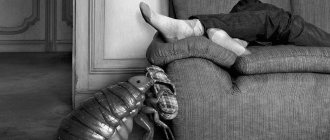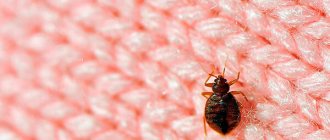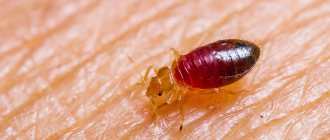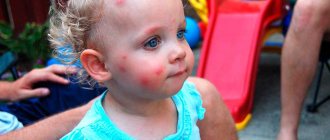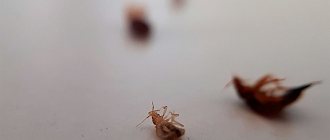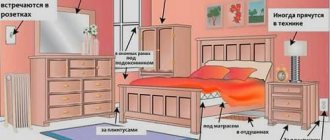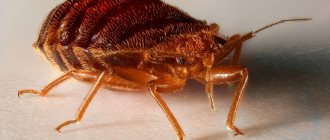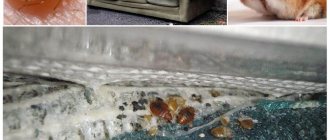Are bed bugs dangerous?
Finding out where bed bugs come from in an apartment is important in a preventive sense.
The answers will help avoid re-infection of premises. Which is very important, because bloodsuckers can not only cause night discomfort with their bites, but also be carriers of serious diseases. Persons with increased sensitization of the body to irritants will suffer from severe allergies after an insect bite. Therefore, in parallel with clarifying the question of why bedbugs appear in an apartment, it is important to understand how to combat them with parasites using effective methods. Insects easily adapt to difficult living conditions, so with a large population, grandma’s methods will not help.
If, during an inspection of the premises, several nesting sites for pests were discovered, it is better to call a professional exterminator. Otherwise, you will have to re-deal with why bedbugs appear in the apartment after control procedures.
Where can trouble come from? Causes of bedbugs
Insects are not a disease and they do not appear in your apartment on their own, even if you are not the biggest fan of cleanliness. Where do bedbugs come from even in a clean apartment? Let's find out!
Migration from neighbors
For a long time, you may not even realize that entire hordes of bedbugs live somewhere nearby. They usually begin to change their home for several reasons:
- neighbors called exterminators and the surviving individuals are trying to escape;
- the neighbors have moved out of the apartment and the bedbugs need to look for food;
- the heating was turned off in the apartment and the insects became too uncomfortable;
- During work, they removed old baseboards or tore off wallpaper and stirred up nests.
In any of these cases, the bugs begin to look for better conditions for existence and end up with one of the neighbors (or they all get “lucky” at once). It is very difficult to avoid such a phenomenon, because... You yourself don’t always know what holes and cracks there are in the apartment.
Old things
Domestic parasites prefer to build deeper nests in cracks, seams of textile items, between the folds of clothes that have been stale, etc. If you are wondering how bedbugs are transferred from one home to another, you need to remember that this happens along with things. For example, if the owner decided to sell furniture or clothing, but did not properly inspect it for defects, then parasites may remain inside.
More often
In this way, insects are transmitted inside furniture and household appliances.
Chemicals are also used to kill bedbugs in clothes.
Open space
When studying ways of how bed bugs appear in apartments, if the owners are sure that they have not previously been to dubious places, you need to remember that the likelihood of this is low. After all, blood-sucking insects of this species really do not live in open areas. However, in this case, an external factor may influence - a stranger with whom the person is located.
There must be direct contact
(for example, a hug when meeting) so that the insect crawls onto the clothes of the new owner.
Bedbug eggs on human clothing
People are carriers of bedbugs
If friends who have bedbugs in their home sometimes come to visit, then sooner or later the parasites will move to a new place. They may end up inside the clothes that a person put on before going outside. The insect may fall out of the jacket in a new place.
To infect an apartment, 1 parasite is enough, it must be a female. She has the ability to reproduce without a male. In rare cases, a bedbug can travel on a person's clothing.
Bloodsucking travelers
In this case, people bring insects from trips - in suitcases, folds of clothing. Infection occurs in cheap hotels/hostels or trains. To prevent insects from entering an uninfested house in this way, you need to understand what causes house bugs to appear in places where travelers often stop.
There is only one reason - violation of sanitary standards
owners of hotels and other cheap housing. When rooms are rarely and not thoroughly cleaned, signs of infection may not be noticed.
Bedbugs have established a colony in a suitcase
Inheritance from previous residents
Bedbugs may come from previous residents. Not all previous owners of the apartment will admit to you that such a problem exists, and if the apartment was rented out, then quite honestly they might not even have known about bedbugs. But even if the presence of insects was known, not everyone knows how to fight them properly. Many people still believe that it is enough to treat and/or throw away upholstered furniture and everything is fine. Whereas bedbugs remain under baseboards, wallpaper, and various crevices and are simply waiting in the wings.
The presence of bedbugs can be indicated by a specific and not the most pleasant smell in the room. Exterminators know it well and can immediately determine the presence of bedbugs. If you have any doubts, it is best to contact specialists and call them to inspect the apartment. By starting the fight in a timely manner, you will save yourself and your loved ones from bites and prevent bedbugs from settling in your new furniture.
New furniture
Favorite habitats for insects are holes in sofas and beds, joints and back panels of furniture, since bedbugs are not visible there, which means parasites can easily create their offspring. Of course, there are ways to get bedbugs out of a sofa or bed, but it’s better to prevent the problem than to get rid of it.
Unfortunately, sometimes even new furniture is home to these bloodthirsty inhabitants, which then end up in your possession if you do not check the furniture properly before bringing it home;
Appliances
Sometimes it is extremely difficult or even impossible to understand where the parasites came from. And all because bedbugs are very small insects and can even settle in the hollow holes of various household appliances. They are attracted by the warm engines and coolers of both new equipment and those that you took in for repair;
Accidentally getting into a suitcase or bag
Most often, this is possible after a person returns from resort, but not the best hotels. It is clear that not every person is able to spend a serious amount of money on a decent hotel, but the risk you run by spending the night in unclean, damp rooms for a few days at sea is not at all worth it;
On animal fur
If bedbugs appear in an apartment, this is noted as the least likely reason, since the parasites move by accident using this method. For example, if bedbug eggs stuck to the fur when the pet was rummaging through old things left near the trash can, or spent some time with a neighbor's animal on his territory.
To bring insects home,
a dog/cat doesn't need much time. As a result, a colony of parasites will soon appear.
You will not find bedbugs on the fur of domestic animals, with the exception of house rats and bats
Trip to nature
The chance of bed bugs being nearby in the wild is slim. Such insects live inside residential buildings. During the day they do not attack people; they only get outside the home (on the street) by accident. If you are interested in the life activity of house bugs, where do such parasites come from, to answer this question, you need to understand that they can be brought home from the street among things that friends gave, for example, during a trip.
They can also linger inside clothes.
If friends exchange jackets in nature, the parasite will end up in a new home, where it will settle down. However, the likelihood of this, again, is small.
Theoretically, bedbugs can be carried on things
Where and how do bedbugs live in an apartment?
The bug lives from 12 to 14 months. He needs to feed on blood regularly, about once every 5 to 10 days. If food becomes unavailable, the insect goes into suspended animation and lives in this state for more than a year, even at low temperatures. In search of food, insects migrate through ventilation ducts, along the outer walls of houses, and can move by settling on the fur of an animal. On their own, the imago (adult bug) travels 1 m in a minute, and the nymph (young individual) - up to 25 cm.
Adults do not tolerate sudden drops or increases in temperature. Like the larvae, at -17°C they do not live longer than a day. At temperatures from +45°C and above, adults and larvae die after 45 minutes.
Bedbug, I'm coming to look for you!
If you are convinced that parasites live in your home, find out where their colonies are concentrated. They do not have nests like ants, but they live in groups in the most comfortable places for these insects.
The “bed” bug lives next to its breadwinner. For proper nutrition, he needs the person to sleep soundly and not move. The bloodsucker only bites in open places; it does not go under pajamas or blankets. Therefore, it settles in a mattress or in the upholstery of upholstered furniture. Ectoparasites do not live in bedding because it is changed, washed and ironed.
Where to find a bedbug at night?
From 3 to 8 am the parasites go hunting.
If you turn on the light suddenly, they can be seen in the bed next to the victim. Individuals who have not yet drunk quickly retreat, and those that are well-fed will slowly crawl back into their burrows. Trying to get rid of ectoparasites by night “catching” is pointless. You will have to forget about sleep, and the insect population will recover very quickly. You won’t catch them all, because they feed once every few days, which means that someone will hide in a shelter, and the larvae, when they grow up, will replace the destroyed adults.
A third of the bedbug colony lives in the box spring, frame and slats of the bed. It's warm, dark and there's a person nearby. In addition, people rarely look under the mattress, which means it will be difficult to declassify their nest.
Where do bedbugs hide during the day?
During the day, a small population of bloodsuckers hides in the mattress. If there are a lot of bedbugs, they have to settle in new places. Most often they settle in:
- upholstered furniture;
- cracks between furniture, walls and floors;
- under baseboards;
- in curtains;
- in carpet pile;
- in the nightstand by the bed;
- in sockets;
- behind the paintings;
- under linoleum;
- behind the battery;
- in electrical appliances;
- behind a layer of peeling paint on the walls;
- between books.
These are the places where you need to strike the main blow!
Where do bedbugs like to live?
Bloodsuckers inhabit the back side of the sleeping area. If there are holes in the upholstery of a sofa or bed, it will be very convenient for insects to hide there. A foam mattress is an ideal place: it is warm, there is enough air, and the pores are comfortable for laying eggs. If not the entire population fits on the back side of the bed, some have to live in the armrests, drawers and on the sides, pushed towards the wall.
All furniture with foam layers is suitable for ectoparasites to live in: ottomans, chair-beds, pillows. In wooden furniture, they hide in cracks and joints, waiting for the night, and the females lay eggs. The larvae do not lay on metal and tiled surfaces.
Features of insect life
A bedbug is an arthropod, a blood-sucking insect. Body size varies from 3 to 8.5 mm. The more the bloodsucker feeds, the larger it becomes. The human bed is its favorite habitat, for which it received the name “bed”. The body shape is wide and flattened, making it difficult to crush the insect and it moves easily in tissue folds. Features of life:
- Female and male individuals, as well as bedbug larvae, feed on human blood and are nocturnal, attacking from 3 a.m. to 8 a.m.
- In the morning they hide in clothes, a mattress, climb into books, under wallpaper and baseboards. When they are very hungry, they go hunting during the day, but this happens extremely rarely.
- Parasites run fast. One adult is capable of covering 1 meter in 1 minute. They make their way into neighboring rooms along the walls or through ventilation systems.
- They find shelter and prey using their sense of smell, which is well developed. They prefer to hide in dressing gowns and other clothes that the victim most often wears.
- Bed bugs feed once every 7 days. In this case, the larva drinks 1 mg of blood in one bite, an adult – 7 mg. In addition to humans, parasites are capable of attacking domestic animals and birds.
- Fertilization of the female occurs through traumatic insemination. To introduce the seed, the male pierces the female's abdomen with the genital organ. After 2 weeks, she begins to lay 5 eggs daily. Over a lifetime, up to 500 pieces are produced.
- A month later, a larva emerges from the egg. If the conditions for development are unsuitable, the birth process is delayed up to 3 months. For further growth, the larva requires food, in search of which it sets out immediately after birth.
- After 30 days, new individuals will be able to reproduce, so the colony of insects quickly grows, capturing new places.
- Bedbugs cannot fly because they do not have developed wings. They can't jump either.
Bedbug saliva contains painkillers, so their bites are painless. Parasites do not tolerate infectious diseases, so they are considered not dangerous to humans. Those who are prone to allergies should be wary. The bite sites swell, then itchy blisters appear.
Looking for bed bugs by following tracks in bed
One way or another, a person sometimes becomes dissatisfied with the signs described above.
He wants to see the parasite in person. There is one way to catch bloodsuckers red-handed. To do this in the evening, lay a white sheet on the bed and turn off the light. In the dead of night, at about 3 o'clock, turn on the lighting sharply and inspect the sheet. As a rule, at least a few pieces will end up there.
Unlike mosquitoes, which inject a substance when they bite that allows the blood to clot, bedbugs do not know how to do this. After their attack, several drops of blood are released from the wound. The man tosses and turns and a little blood flows out of the wound. Accordingly, the next morning you can easily notice these traces.
Remove bedding and inspect carefully. Do the same with the blanket. Blood trails will almost certainly tell you that there are parasites in your home.
Signs of the presence of bedbugs in the house
It is quite difficult to detect bedbugs even if they have already multiplied to large numbers. These insects are nocturnal, and during the day they are usually found in secluded places. But there are several signs by which you can accurately determine that your apartment has become a haven for parasites:
Bite marks on the body
They resemble a mosquito bite (red, inflamed bump), but are more numerous and are arranged in a “path”, because one insect makes several punctures in the skin, gradually crawling until it is satiated. Bed bugs especially often bite children, since their skin is delicate and thin, which can be bitten through without much difficulty.
Presence of a specific odor
Males have glands on their abdomen that secrete a secretion to attract females for mating. This is what causes the stench. The smell from it is reminiscent of a “cognac” aroma, which is stronger in places where insects are most concentrated - under carpets on the wall, on furniture (bugs especially love the back walls of cabinets, kitchen stoves, refrigerators). And also, sometimes this smell is associated with walnuts, spices, raspberries or bananas.
The presence of small brown spots on the bed
When a bug attaches itself to a person’s skin, it injects a substance through its proboscis that prevents blood clotting and at the same time relieves pain. Therefore, droplets of blood fall on the bed after the insect falls off the wound, dry out and become dark brown or brown in color.
Black dots from bedbugs
Black spots the size of poppy seeds are found under the mattress or next to the bed. As well as accumulations of debris, which, upon closer examination, turn out to be the remains of chitinous shells left by larvae and hatched eggs. Why do bedbugs leave black dots? In fact, this is their waste. Just as a person needs to go to the toilet, a bloodsucker needs to eliminate food debris in the form of specks of processed blood.
The first signs of bedbugs in upholstered furniture
The following signs indicate that there are bedbugs in the sofa:
- Black spots on furniture and bedding. These are waste products of blood-sucking parasites.
- Pinpoint bites on the skin in the form of a track, which appear 1-2 times a week: bedbugs do not feed on blood every day. A person can receive about 500 bites in one night. The bite site is a swelling with a bright red dot in the center.
- The appearance of an unpleasant odor. Bedbugs give off a specific smell, which has been compared to the aroma of nutmeg, rotten raspberries or cheap cognac. Furniture in which these blood-sucking insects parasitize acquires a stale, musty smell.
- Traces of blood on the skin and bed linen. They remain after insect bites, and also if a person, changing body position in a dream, crushes them. Traces of bedbug excrement are observed not only on the piece of furniture that they occupied: black dots appear within a radius of 3-5 m from it, on the walls, in the area of the baseboards. Bedbug bites not only cause discomfort: they can cause allergic reactions, the formation of ulcers with the addition of a secondary infection, and in severe cases, iron deficiency anemia.
Bedbug habitats
Bed bugs, despite their name, do not hide on the bed, but in darker, more secluded places. If these insects lay eggs on the bed, then there is a high probability that if you toss and turn in your sleep, you will crush all the offspring of the bug. Therefore, these bloodsuckers find less noticeable places, which are located near sleeping places and begin to multiply at incredible speed and bother you with bites. In addition to beds and sofas, the favorite places for bedbugs in your apartment are:
- Dressers;
- Wardrobes;
- Various bedside tables;
- Floor lamps;
- Curtains;
- Books;
- Skirting boards;
- Doorways;
- Sockets;
- Wallpaper;
- Window frames;
- Paintings;
- Tapestries;
- And even household appliances.
The very first place where blood-sucking insects can hide is under mattresses. If, after picking it up, you find parasites, then it’s time to carry out pest control for bedbugs.
How to detect furniture bugs?
The main sign of bedbugs appearing in the house is a sheet stained with small blood spots and the presence of itchy bites on the body. It is difficult to detect an insect during the day; bedbugs most often come out of their hiding places at night, when the victim is lying in bed. But individuals living in furniture can bite a calmly lying or sitting person even during the day.
The main signs of the presence of bedbugs in an apartment.
The bite is not too sensitive, but the itching often interrupts a person's night's sleep. In the morning, characteristic bite marks can be found on the body: a chain of several bloody puncture points. Sometimes you can find a crushed dead insect on the bed.
An indirect sign of the presence of bedbugs is an unpleasant odor reminiscent of almonds (or cognac aroma). In the folds of the mattress and on the light upholstery of the sofa, one can also see dark dots left by several individuals hiding there before the cleaning began. If there is at least one similar sign, it is worth looking for the habitats of parasites and starting to destroy them.
Where are they hiding?
Particular attention should be paid to the furniture on which home owners sleep or often sit: sofas, armchairs, beds, etc. Bedbugs do not move long distances in search of victims, and you need to look for them near those places where bite marks or blood are most often found spots.
Need to inspect:
- seams and decorative folds on upholstered furniture;
- joints of backrests and seats;
- gaps between the seat and armrest;
- the underside of the mattress on the bed, seats and pillows on the sofa and similar places;
- removable covers on furniture cushions;
- in a sofa bed with drawers for linen - slots in the lower compartment, a soft base and a wooden frame for the pull-out part (bugs rarely live in metal parts);
- on a wooden bed - all the joints of its frame.
Favorite habitats of bed bugs in the apartment.
Dark spots on fabric or wood - traces of excrement - can help in detecting bedbugs. They are located in large numbers around the crack where insects hide. You can also see larvae in the seams of upholstered furniture - small light grains about 2 mm long. During growth, the larvae change their shell several times, shedding the old cover. The presence of dry shells will also help to detect a bedbug colony - they resemble dead bugs.
Brief characteristics of the insect
Bedbugs are six-legged insects with semi-rigid wings. Bedbugs are found almost everywhere. Even Greenland or Chukotka are not bedbug-free areas.
There are many species (more than 30 thousand) of harmful insects. People can treat water striders, turtles, soldiers and other species calmly, although they try to protect cultivated plants from them. But other species are not just unpleasant, but dangerous to humans.
These include blood-sucking parasites: bedding (linen), sofa (furniture). Despite their tiny size (4 to 8 mm), these flat insects cause big problems. The bug is capable of piercing a person’s skin, using one existing proboscis to numb the injection, and using the other to suck blood from the wound. Moreover, blood in 10 minutes. it drinks twice its weight, so a well-fed bug becomes 2 times larger.
Bedbugs are very tenacious and reproduce quickly. One female manages to lay about 500 eggs in a year (the average lifespan of a bug). A month will pass, and each will grow into an adult insect, and each will look for an opportunity to feed on human blood.
The harm caused by bedbugs also increases because people do not immediately notice their appearance and do not always begin to fight them in time. And the number of parasitic insects that appear in the house increases during this time. And along with them, the problems from their presence in a person’s home increase.
Danger of bedbugs:
- allergic reaction to a bite, skin irritation, itching, swelling of the skin, infection in the wound when scratching;
- multiple wounds that do not heal for a long time;
- the possibility of transmitting infectious diseases and the danger of contracting them (tuberculosis, typhoid fever, hepatitis, etc.).
Factors of active settlement
If you are interested in why bedbugs appear in apartments, you need to take into account what promotes the colonization and active reproduction, as well as the development of parasites, by creating favorable conditions:
- acceptable temperature on site: +25…+35°;
- normal or slightly increased humidity level;
- the presence of hidden corners in all rooms where people live and spend the night;
- infrequent cleaning allows bed bugs to continue to exist;
- infrequent overnight absences of the apartment owner.
Specific smell
The first signs of the appearance of bedbugs are also associated with a characteristic smell, which intensifies in the apartment every day. Insects are guided in their activities by the sense of smell and themselves have scent glands. They notify relatives about the location of a power source or danger. The work of the glands is activated during the mating season.
On a note!
The aroma from one bug is extremely weak; humans cannot detect it. If the smell is quite strong, it means there are already a lot of parasites in the room. The mating season is in full swing.
The smell of bedbugs in the apartment is reminiscent of rotten raspberries, cheap cognac, and almonds. Some people start to smell like banana. The aroma intensifies with the onset of darkness, since at this time of day the parasites begin their active life. If a specific aroma is constantly present, the number of bedbugs in the apartment amounts to several hundred individuals.
Danger to humans
The greatest danger to humans is an allergic reaction. It occurs due to enzymes injected into the wound, and microparticles of chitin and excrement rising into the air with dust. Often an allergic reaction occurs even in people who are not prone to it.
Allergic reaction to a bedbug bite in a child.
Like all bloodsuckers, house bugs are capable of carrying serious diseases:
- typhus;
- tuberculosis;
- yellow fever;
- pseudotuberculosis;
- tularemia, etc.
Infection of an insect can occur from a previous owner, and, moving to a new one, the bug is capable of infecting it during its life.
If a private home is inhabited by rodents, with which bed parasites sometimes also come into contact, then the list of diseases will be even wider.
How do bedbugs spread?
Bedbugs reproduce very quickly. As soon as one female gets inside the house, the parasites begin to spread at an incredible speed . The female bedbug can store fertilized eggs for up to several months, waiting for favorable conditions to lay larvae.
Since newborn bedbugs are ready to reproduce within a month, the population grows to large sizes very quickly. Bedbugs occupy furniture, hide under the mattress in the bed, under the baseboards.
These insects lay eggs all year round. Unfavorable conditions, cold or chemicals stop this process, but if the situation returns to normal, the bedbugs will begin to reproduce again.
How do they reproduce?
Bed bugs lay eggs
Bedbugs mate using “piercing”; the bug pierces the female with its genitals and injects sperm into her body, which results in almost 100 percent fertilization. Female bedbugs can lay up to 5 eggs per day. In total, during its existence there are up to 500 eggs. The full development cycle of a baby bug occurs in a month.
Bed bugs hide eggs in upholstered furniture, clothing, household appliances, electronics, animal fur, books, various bags and boxes.
Many people recommend this remedy for bedbugs. Read >>>!
How to avoid bringing bedbugs from an infested apartment?
If you often travel and go on business trips, living for several days in rented apartments or hotels, then when you move in, you should immediately bring your things into the bathroom. Blood-sucking parasites do not live there and will not be able to get into the suitcase. It is advisable to inspect the rest of the room for traces of bedbugs.
If they are found, treat everything with any insect repellent (Raid, Raptor, etc.).
In a dangerous apartment, it is advisable to leave bags with things locked. If you use your own bed linen, it is advisable to wash it at high temperature before leaving or pack it separately in a sealed bag so that it can be processed at home.
If you have doubts about the cleanliness of a room where you have to enter for a short time, you should refrain from sitting on upholstered furniture.
How to get rid of bed bugs, how to remove them
Bed bugs on furniture
- Alternatively, you can “spray” yourself with perfume (if you have to spend the night in an infested apartment, and there are no other means of protection), the parasitic insect cannot tolerate the smell of perfume, although there is a possibility that if the bug is very hungry, then overcoming the aversion to the smell of perfume, it will return and will suck blood with even greater ferocity.
- You can try pouring boiling water on the bedbugs, or even use spells: “You bedbugs, bedbugs, don’t bite me. Your teeth are made of burdock, but my body is made of flint.”
- Throw out furniture in which bedbugs were found, get rid of infected things.
- “Freeze” the apartment so that the bug dies from the cold.
- From natural, natural remedies, you can use tansy leaves, or an infusion of wild rosemary.
How to destroy?
If bedbugs do come from somewhere, or at least there are suspicions of their presence in the apartment, then the fight can be carried out in different ways. The most common and accessible means are industrial aerosols. But sometimes their use is impossible for some reason and you have to use ancient folk methods or resort to the services of professionals.
Traditional methods of controlling and preventing bedbug infestation at home
Having found out why bedbugs appear in the house, we will figure out how to deal with them without risk to household members and pets. Folk remedies are considered gentle. They are also recommended to be used as preventive measures for re-infection of premises. Therefore, devote time not only to finding out where bedbugs come from in your apartment, but also how to get rid of insects. There are several means:
- spread plants with a specific smell in the infected room (the entire apartment, if parasites are found, at least in one room) - chamomile, calamus, wormwood, tansy, wild rosemary, etc. These odorous herbs will not kill the “uninvited guest”, but will prevent its appearance. Fresh bouquets will relieve household members of the need to wonder where bedbugs come from in an apartment where there are no pets;
- wash floors and wipe dust in the apartment with infusions of the above herbs. Wet cleaning with decoctions 2-3 times a week will eliminate the need to solve the problem of how bedbugs appear in the house after disinfection;
- When wet cleaning, wipe the floor, furniture, baseboards and other comfort zones of parasites with vinegar, ammonia, acetone, mothballs or kerosene. It doesn’t matter why bedbugs appear in residential areas, it is important how to effectively and safely deal with them. And the listed products are the strongest repellers of bloodsuckers, which can be bought inexpensively in a specialized store;
- Place bouquets of fragrant herbs in the ventilation holes of the rooms. Knowing where bedbugs come from in residential areas, these are the routes of entry that should be protected.
Folk remedies are effective for small populations of blood-sucking insects and as preventive measures. They are safe for both households and pets, but not as an effective measure. If you find bedbugs in your apartment, the reasons for which are described above, and you want to get rid of them quickly, you need serious measures. Either professional exterminators or ready-made industrial preparations will help here. Household insecticides will kill bedbugs in a house where they would not have come from - how to get rid of “uninvited guests”, and with what drugs?
Household products
Household chemicals include preparations with cypermethrin and related substances, karbofos, and other pesticides intended for treating residential premises. When choosing, you need to pay attention to what species the drug is recommended for: it is better to poison bedbugs with means for crawling parasites.
Among the available household chemicals, the most effective are:
- Aerosols. Preparations such as Raptor, Raid, Combat Dichlorvos and the like are specially designed to combat various insects. The peculiarity of the application - spraying - allows microdroplets to penetrate even the narrowest cracks, overtaking bloodsuckers even in their shelters. After treatment, parasites sometimes begin to crawl out in large numbers into open areas.
- Solid drugs. Used in 2 varieties: chalk and powder for dusting. Chalk (Mashenka, Brownie, etc.) allows you to create a toxic barrier, upon crossing which the insect will already be poisoned. Returning to the colony, the bug will bring poison to the shelter, contributing to the death of the larvae. The chalk will not affect the eggs, but the bugs will stop appearing, because they will die at the first contact with the chalk strip. Powders are used to pollinate any surfaces inside and outside furniture.
- Solutions. Chemical solutions are prepared strictly according to the instructions. You can use garden preparations (FAS, Karbofos, Fufanon, etc.) and special household products (Executioner, Bedbug beetle, etc.). Spray with solutions and moisten the places where traces of bedbugs are found. The drugs exhibit toxicity within several days or weeks, and treatment is repeated if necessary.
- Gels. The thick form contributes to the long-term preservation of the toxic mark on wooden surfaces. But household gels (Foxide, Get, etc.) stain textile surfaces and have a limited range of applications.
Professional preparations
Among the professional preparations intended for disinfestation are highly concentrated solutions based on the same toxic substances as household chemicals. You can use them yourself, using only the dosages recommended by the manufacturer for preparing the working solution.
Treatment is carried out using spray bottles or garden sprayers, observing safety precautions (protecting the mouth and nose from inhaling the spray).
Products such as Cifox, Sinuzan, Forsyth, etc. should not be purchased in large packages. For 1 liter of solution, 2-5 mg of emulsion is enough, so for home needs it is enough to purchase a package of 50-100 ml. During disinsection, remove everyone who is not involved in the work from the premises for 5-6 hours. After treatment, the apartment must be ventilated to remove odors and toxic fumes.
Professional help is the best solution in the fight against bedbugs
Are you still thinking about the question: what to do if there are bedbugs in your bed?
According to expert advice, the best way is to dispose of contaminated items. If you don’t want to say goodbye to your favorite bed, antique sofa or wardrobe, we suggest you trust the professionals. There are special services and companies that provide services to get rid of parasites such as bedbugs. Experienced experts know how to get rid of parasites quickly and easily.
In their work they use:
- Special equipment. Thanks to it, you can carefully treat all places, cracks, and holes. This leaves insects no chance of survival.
- Proven chemicals. Specialized companies work with effective means that guarantee 100% elimination of insects. They choose chemicals that kill not only adult bedbugs, but also their eggs and larvae. It is simply impossible to find professional poisons on the open market.
Contacting a specialized service is a chance to get rid of the problem once and for all. Specialists work at a high level. They guarantee safety. Therefore, professional treatment of apartments and houses does not affect the health of pets, people, or plants. There are no traces left even on pieces of furniture or interior decor. The key to success lies in practicality. Professionals work quickly. During the treatment period, you don’t even need to think about where to leave home. You can return to the treated apartment or house after a couple of hours.
Preventive measures
Pests often appear without human intervention. However, you can take measures to reduce the risk of their occurrence in the home:
- after long trips and business trips, it is recommended to take all items to dry cleaning if there is a suspicion of the presence of domestic (bed) bugs;
- when visiting suspicious premises, clothes must be dried at temperatures above 50 degrees for a long time;
- seal cracks, baseboards, etc.;
- treat ventilation openings, windows and doors with special preparations or hang branches of lavender, wild rosemary, and wormwood.
Signs of house bugs
All bedbugs are similar to each other. If you have seen red soldiers on a tree in the park, then you know their main characteristics. They have a flat body, hard wings, a back, short legs and a head separated from the body with a sucking organ. In addition to red parasites, you may also be aware of small green ones that live in raspberries and other berries, and large gray-brown potato pests.
Domestic bed bugs differ from all others in their small size, lack of patterns on the back; adults are brown, newborns are transparent or pale yellow, thin and soft. At different stages of development, they can resemble all insects at once: cockroaches, lice, ticks, ants, fleas.
Read also: How to transplant Decembrist at home step by step
